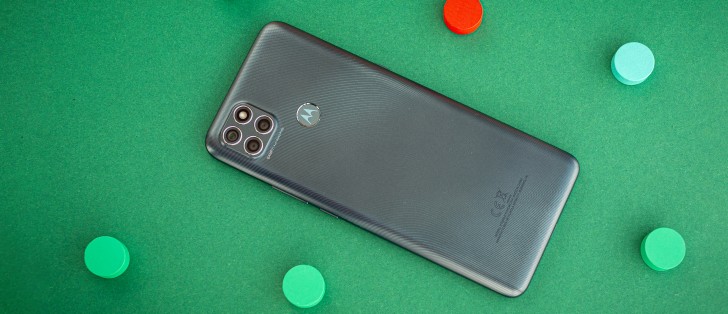Moto G9 Power review

A triple-camera on the back
The Motorola Moto G9 Power has a triple camera on the back with a primary/macro/depth setup. This is a massive downgrade from the Moto G8 Power camera.

The G8 Power had a wide primary plus ultrawide plus telephoto plus macro arrangement. That was quite the hardware, given the budget class and price. Now, the new G9 Power loses the ultrawide and the macro, replacing them with a depth sensor. The primary camera was given a high-res 64MP sensor, though (vs. 16MP on the G8), a silver lining of sorts.
So, the main camera of the Moto G9 Power uses a 64MP 1/2" OmniVision OV64B sensor with a Quad-Bayer filter. The sensor has 0.7µm pixels, and after the 4-in-1 binning, you'd be getting a 16MP photo with 1.4µm equivalent performance. A high-res 64MP mode, Pro Mode, as well as Night Vision are available for this camera.
The macro camera uses a 2MP OmniVision OV02B1 sensor behind f/2.4 lens. This shooter supports autofocus and Pro Mode, both extremely rare among the macro snappers.
Finally, the depth sensor has the same 2MP OV02B1 sensor with f/2.4 lens as the macro cam.
The selfie camera packs a 16MP 1/3.06" OmniVision OV16A1 sensor with 1.0µm pixels and a Quad-Bayer filter. The sensor is behind an f/2.0 aperture lens that has a fixed focus. Being a Quad Bayer type of module, the selfie cam takes 4MP images by default, but this one can be set to output 16MP shots if that's necessary.
Motorola has been installing its own custom Camera app on the otherwise mostly stock Android software, and that's the case on the Moto G9 Power, too. It is straightforward and functional, with a swipe action for switching between stills, video, and assorted modes (tapping on the icons works).

A set of quick settings is available in the viewfinder for the HDR modes (Auto/On/Off), flash modes (Auto/On/Off), self-timer (Off/3s/10s) and Active Photos (Auto/On/Off). There's also a shortcut to the settings menu right in the viewfinder.
The Manual mode is accessed from another toggle in the viewfinder - not the extra modes. It lets you dial in your own ISO (100-3200), shutter speed (1/6000s-32s) (or up to 1/2s in macro), or exposure compensation (-2EV to +2EV in 1/3EV and 0.5EV increments). You can also pick a white balance by light temperature (with markings for common light types), and you can manually adjust focus - all pretty standard. There's also a tiny live histogram.
Photo quality
The 16MP photos from the main camera are excellent for this class and turned out a lot better than we expected. They are plenty sharp and rich in detail, even in areas of high complexity. They aren't overprocessed, evident by the apparent noise and natural-looking foliage (like grass).
Contrast is excellent, and so is the dynamic range. The colors stayed true to life in most scenes, too.
Overall, we liked what we saw, and these photos are definitely of high quality, better than the ones coming from the regular 16MP camera on the Moto G8 Power.
And while we are talking about the G8 Power - do you remember it also had an 8MP telephoto shooter? Well, if you crop the center of these G9's 16MP images, you'd get a 4MP 2x zoomed photo, quite detailed at that, so we'd say few are going to miss the zoom shooter (and it had its issues anyway).
There is also a high-res 64MP mode, and it does a good job in saving one detailed photo, though it seems to be lacking any sort of processing - be it HDR, noise reduction, or sharpening. Downsizing such photos to 16MP didn't seem to offer more detail than the default ones, but if you don't like the Moto's take on a scene, the full-res 64MP option is a good alternative then.
Note that shooting in 64MP takes a couple of seconds, and a 64MP photo weighs about 20MB.
The Moto G9 Power omits an ultrawide camera, and that's a bummer. It does support high-res panorama mode (up to 180-degrees), though, so if a super-wide photo is a must, you aren't without options. Your subjects better be standing still, though.
The 2MP depth camera should be helping when shooting portraits. And it probably does, as the 16MP portraits we took with the primary camera are excellent - the detail is abundant, the contrast is excellent, and the subject separation is proficient enough for this class. The artificial blur looks quite good, too.
Note that when light conditions are not ideal, the photo sharpness will drop, rather drastically at that.
The 2MP macro camera has a dedicated shooting mode, and it even supports autofocus. The 2MP photos are okay, but even with autofocus, they were more often miss than hit. And then their quality turned out to be a mixed bag - the detail is enough, but they are often noisy, with mediocre contrast and washed-out colors.
The 16MP low-light photos aren't that good - they are underexposed, poor in detail, and quite noisy. The colors are washed-out, too.
Night Vision is available on the main camera, and it does improve the exposure and the color dramatically. It also gets rid of the noise, but the left detail is even less than regular snaps.
Sure, the Night Vision photos aren't good in full resolution but resize them to 8MP or even 4MP, and you'd be looking at some great snaps that will do a fabulous job for sharing with friends and family.
We also shot our usual posters with the Moto G9 Power. Here's how it stacks up against the competition. Feel free to browse around and pit it against other phones from our extensive database.



Moto G9 Power against the Poco M3 and the Moto G8 Power in our Photo compare tool
Selfies
The Moto G9 Power has a 16MP Quad-Bayer selfie shooter behind an f/2.2 fixed-focus lens. It saves 4MP images by default, as it should, but if you want - you can set it up to save upscaled 16MP photos instead.
The 4MP images show good detail, excellent colors and contrast. The dynamic range is limited, but the Auto HDR helps to expand that more than enough.
And if you wonder what the 16MP selfies look like - here are a few. As we said - they look upscaled from the 4MP images.
You can do portrait selfies, too, and they are good, too. The subject separation isn't as proficient, but the algorithm masks this with blurring and the results are acceptable. The portraits are also good in detail and with nice contrast.
Video quality
The Moto G9 Power captures 1080p videos with its main camera, both at 30fps and 60fps. Unlike the Moto G8 Power, the G9 Power cannot shoot 4K videos.
The 1080p footage from the main camera is average in detail but with good colors, contrast and dynamic range. Noise is handled well, too.
Video is captured with 20Mbps, while audio is recorded stereo with 256Kbps.
Electronic stabilization is available on 1080p@30fps, and it does what it is supposed to do - stabilize the footage at the expense of some fine detail and minor FoV loss.
Finally, closing this camera section off, here is the Moto G9 Power in our video comparison database.



1080p: Motor G9 Power vs. Poco M3 against vs. Xiaomi Redmi 9 in our Video compare tool
Reader comments
- Art
- 25 Apr 2024
- n{e
Still using this thing since 2020, everything works fine, the battery holds up to its name.
- Rpr
- 21 Dec 2022
- y6V
Bought this phone in 2021 on a flash sale for only around $100. So far, still working fine. For ordinary phone users and not heavy into gaming nor social media, this is pretty much a good reliable phone. It comes with a good storage size that's...
- K7
- 16 Nov 2022
- rKi
Suddenly hanging and front camera is show the face is light red colour and back camera is new phone standard still (20th months)don't have other wise good
























































